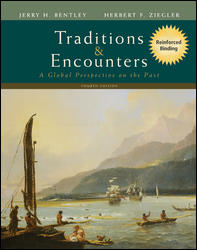 
Traditions and Encounters, 4th Edition (Bentley)Chapter 13:
THE COMMONWEALTH OF BYZANTIUMChapter Outline- The early Byzantine empire
- The later Roman empire and Byzantium
- Fifth century, eastern half of empire remained intact while west crumbled
- Challenges: Sasanids and Germans
- Highly centralized state
- Emperor with aura of divinity--Caesaropapism
- Large and complex bureaucracy
- Justinian (527-565 C.E.) and his legacy; Theodora (empress)
- Rebuilt Constantinople, including Hagia Sophia
- Codified Roman law Corpus iuris civilis(The Body of the Civil Law)
- Sent Belisarius to reconquer the western Roman empire (didn't last)
- Islamic conquests and Byzantine revival
- The emergence of the Islamic state, seventh century
- Arab peoples conquered the Sasanid empire and part of Byzantium
- Prolonged sieges of Constantinople by Islamic armies
- Byzantium survived partly because of Greek fire
- Byzantine society reorganized
- Provinces (themes) under generals
- Armies of free peasants helped agricultural economy
- Byzantium and western Europe: ecclesiastical and political tensions
- Byzantine economy and society
- Rural economy and society
- Large agricultural base to support cities
- Economy strongest when large class of free peasants (themes) existed
- Economy weakened when large landholders consolidated and made peasants dependent
- Industry and trade
- Constantinople was major site of crafts and industry
- Glass, linen, textiles, gems, jewelry, gold, and silver
- Silk developed into major industry in sixth century; secrets came from China
- Constantinople was clearinghouse for trade
- Bezant was the standard currency of Mediterranean basin
- Western anchor of trade route revived silk roads
- Banks and partnerships supported commercial economy
- Urban life
- Housing in Constantinople varied widely by class
- Attractions of Constantinople: baths, taverns, theaters
- Hippodrome used for mass entertainment
- Chariot races most popular; Greens and Blues rivalry
- Classical heritage and Orthodox Christianity
- The legacy of classical Greece
- Official language went from Latin to Greek
- State-organized school system trained workforce
- Primary education: reading, writing, grammar
- Later education: classical Greek, literature, philosophy, science
- Higher education in Constantinople: law, medicine, philosophy
- Byzantine scholarship emphasized Greek tradition
- Wrote commentaries on Greek literature
- Preserved and transmitted Greek thought to later cultures
- The Byzantine church
- Most distinctive feature was involvement of the emperor
- Council of Nicaea (325 C.E.) in which Arianism was declared heresy
- Iconoclasm controversy (726-843) was started by Leo III
- Greek philosophy applied to Byzantine theology
- Monasticism and popular piety
- Monasticism origins in early Christian ascetics (hermits)
- "Pillar saints" like St. Simeon Stylite
- St. Basil of Caesarea (329-379 C.E.) organized monastic movement
- Mt. Athos, monastery in northern Greece from ninth century to present
- Monks/nuns very popular with laity
- Provided social services to the community
- Opposed iconoclasm
- Tensions between eastern and western Christianity
- Constantinople and Rome: strains mirrored political tensions
- Ritual and doctrinal differences, such as iconoclasm
- Schism in 1054--Eastern Orthodox versus Roman Catholic
- The influence of Byzantium in eastern Europe
- Domestic problems and foreign pressures
- Generals and local aristocrats allied; new elite class challenged imperial power
- Western Europe took parts of Byzantium
- Normans in southern Italy and Sicily
- Crusaders carved out states and sacked Constantinople (1204)
- Muslim Saljuq Turks invaded Anatolia, defeated Byzantines at Manzikert, 1071
- Ottoman Turks captured Constantinople in 1453, the end of the empire
- Early relations between Byzantium and Slavic peoples
- Byzantines began to influence Bulgarian politics and culture after the eighth century
- Missions to the Slavs
- Saints Cyril and Methodius, mid-ninth century
- Cyrillic writing stimulated conversion to Orthodox Christianity
- Education and religion tied together, led to more conversions
- Byzantium and Russia
- Mid-ninth century, Russians started to organize a large state: Kiev
- The conversion of Prince Vladimir, 989
- Kiev served as a conduit for spread of Byzantine culture and religion
- Cyrillic writing and literature and Orthodox missions spread Byzantine culture
- Byzantine art and architecture dominated Kiev: icons and onion domes
- Princes established Caesar papist control of Russian Orthodox church
- Russian culture flourishes from eleventh century
- Moscow claimed to be world's "third Rome"
- Sent out many missionaries from sixteenth century on
 |  |
|





